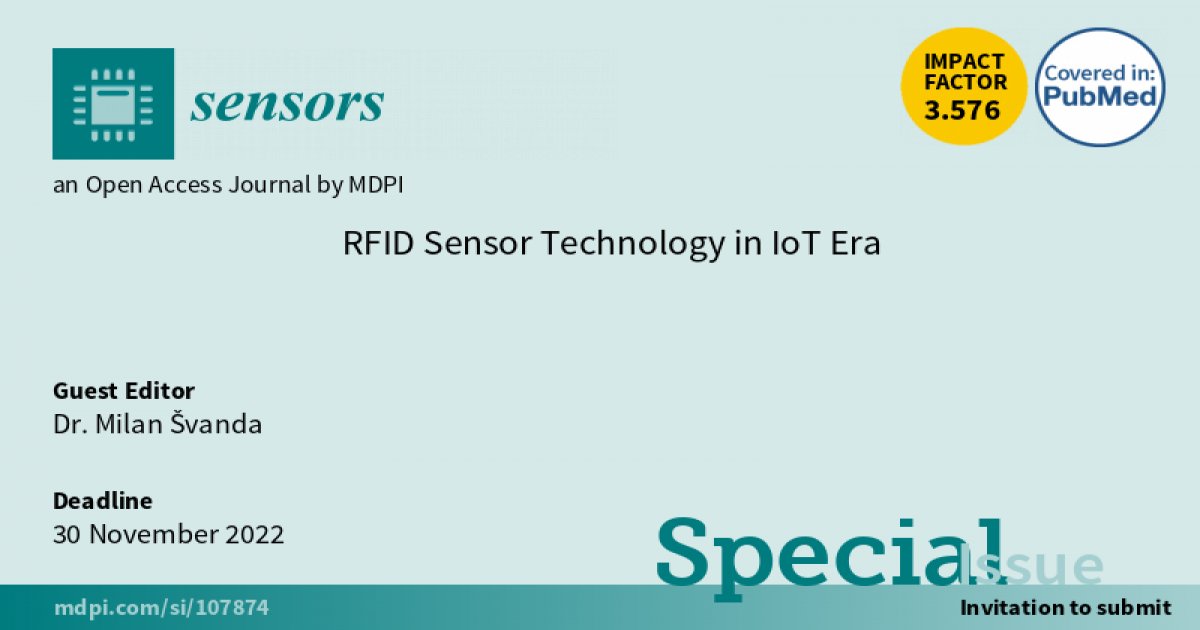RFID Sensor Technology in IoT Era
A special issue of Sensors (ISSN 1424-8220). This special issue belongs to the section "Physical Sensors".
Deadline for manuscript submissions: closed (20 August 2023) | Viewed by 4661

Special Issue Editor
Interests: RFID technology; chipless RFID and sensors; platform tolerant and wearable antennas; special construction of planar antennas
Special Issue Information
Dear Colleagues,
We are pleased to invite you to participate in the Special Issue of the MDPI Sensors journal with the title “RFID Sensor Technology in IoT Era”.
Radiofrequency identification (RFID) is a modern technology whose utilization has gradually expanded into a wide range of identification, tracking, and sensing applications, including the operation of transponders attached to lossy dielectric and metallic objects, human bodies, as well as the integration of RFID transponders with sensors.
Research of RFID with sensing of both electrical and non-electrical quantities is a large challenge for scientists worldwide. Sensing capabilities offered by RFID transponders in the UHF or microwave frequency band are emerging research trends with great applicability to the topical paradigm of Internet of Things, health-care and assisted living equipment, and safety tasks in chemical or other industries. Different transponder concepts are being developed: passive, semi-passive, and active; chip and chipless. Researchers in this field face many challenges that need to be met, such as the high sensitivity of transponder sensors, high range reading, manufacturing transponders by ink-jet or screen-printing technology, reliable identification requiring robust sensing and calibration methods, operation of transponders in complex environments, etc.
We would like to present the current advance in this topical technology through this Special Issue. Original research articles and reviews are welcome. Research areas related to RFID sensor technology may include, but are not limited to, the following:
- Sensing transponders of electrical and non-electrical quantities;
- Platform tolerant and wearable sensing transponders;
- Passive, semi-passive, and active sensing transponders;
- Chip and chipless sensing transponders;
- High sensitivity and read range sensing transponders;
- Ink-jet and screen-printing technology;
- Robust sensing and calibration methods for complex environment;
- RFID reader antennas and systems;
- Internet of Things;
- Review of state of the art;
- Other topics.
We look forward to receiving your contributions.
Dr. Milan Švanda
Guest Editor
Manuscript Submission Information
Manuscripts should be submitted online at www.mdpi.com by registering and logging in to this website. Once you are registered, click here to go to the submission form. Manuscripts can be submitted until the deadline. All submissions that pass pre-check are peer-reviewed. Accepted papers will be published continuously in the journal (as soon as accepted) and will be listed together on the special issue website. Research articles, review articles as well as short communications are invited. For planned papers, a title and short abstract (about 100 words) can be sent to the Editorial Office for announcement on this website.
Submitted manuscripts should not have been published previously, nor be under consideration for publication elsewhere (except conference proceedings papers). All manuscripts are thoroughly refereed through a single-blind peer-review process. A guide for authors and other relevant information for submission of manuscripts is available on the Instructions for Authors page. Sensors is an international peer-reviewed open access semimonthly journal published by MDPI.
Please visit the Instructions for Authors page before submitting a manuscript. The Article Processing Charge (APC) for publication in this open access journal is 2600 CHF (Swiss Francs). Submitted papers should be well formatted and use good English. Authors may use MDPI's English editing service prior to publication or during author revisions.
Keywords
- RFID
- sensing transponders of electrical/non-electrical quantities
- platform tolerant/wearable sensing transponders
- passive/semi-passive/active sensing transponders
- chip/chipless sensing transponders
- high sensitivity/read range
- ink-jet/screen printing
- robust sensing/calibration methods
- complex environment
- reader antennas/systems
- Internet of Things
Benefits of Publishing in a Special Issue
- Ease of navigation: Grouping papers by topic helps scholars navigate broad scope journals more efficiently.
- Greater discoverability: Special Issues support the reach and impact of scientific research. Articles in Special Issues are more discoverable and cited more frequently.
- Expansion of research network: Special Issues facilitate connections among authors, fostering scientific collaborations.
- External promotion: Articles in Special Issues are often promoted through the journal's social media, increasing their visibility.
- e-Book format: Special Issues with more than 10 articles can be published as dedicated e-books, ensuring wide and rapid dissemination.
Further information on MDPI's Special Issue polices can be found here.






